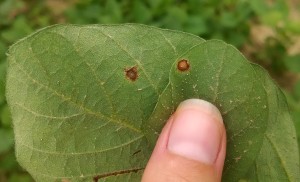Soybean diseases and chemical injury can be difficult to correctly diagnose in the field. Some general information about diseases in soybean and common chemical injury follow to help distinguish between the two.
One of the first things to take notice of is if the newest growth on the plant has symptoms or not. Chemical injury will only occur on foliage that was out when the chemical was sprayed or from water splashing it up from the soil onto leaves, so new foliage will be green without symptoms. Symptoms of common foliar diseases in soybean, such as frogeye leaf spot (FLS), usually don’t develop until reproductive growth stages. Similar looking lesions can be common on earlier soybean caused by chemical burn and can be hard to distinguish, both can have a dark margin and lighter center (Picture 1). Although, chemical burn will usually be close to a perfect circle and FLS may be more angular in shape. The under sides of the leaves are the best area to distinguish the two (Picture 2 and 3). Chemical burn will have a bleached out center (lesions on the right) whereas FLS will have a tan to grayish center and if the lesion is sporulating, in the very center of the lesion there will be a dark black area (lesions on the left).
Pre-emergence herbicides, especially PPO inhibitors and photosynthetic inhibitors (metribuzin), can injure seedlings, particularly when cool temperatures coincide with rain soon after emergence. Spotty necrosis can occur when rain splashes droplets of residual herbicide from the soil onto emerged seedlings or lower leaves. Common symptoms of seedling diseases that are not usually associated with chemical injury include rotten, mushy seedlings with poorly developed roots, water-soaked lesions on the hypocotyl, cotyledons, or stem, and stunted or wilted seedlings.
If unsure if you have a disease or chemical injury contact your local county agent or send samples to your state diagnostic lab.




